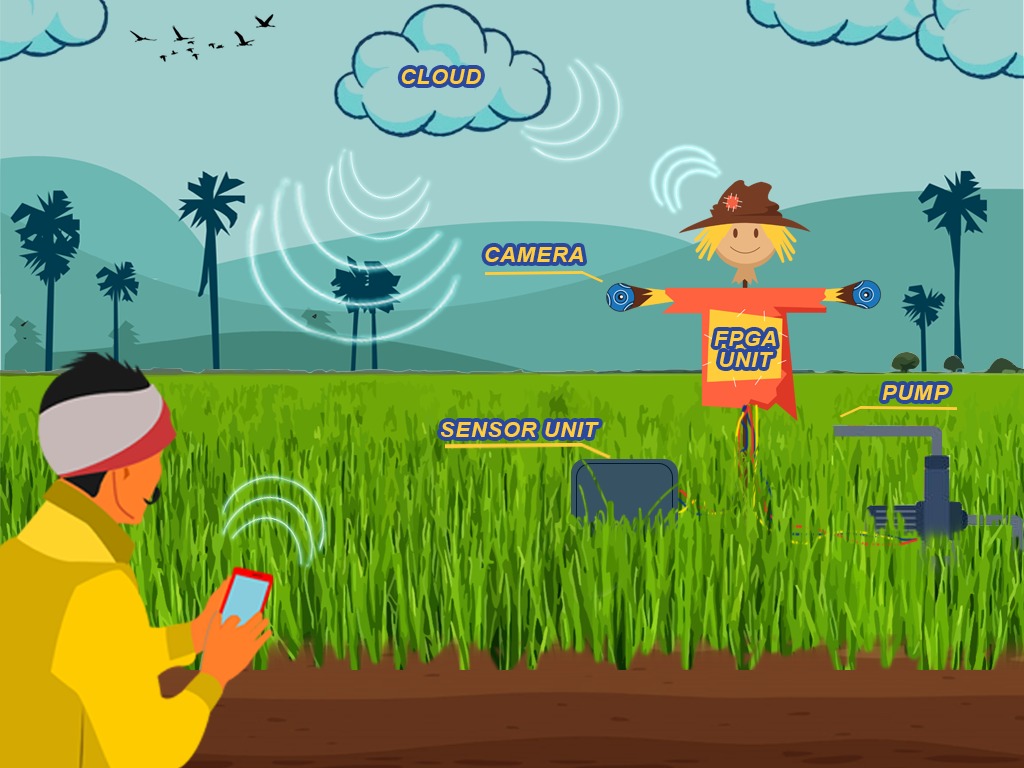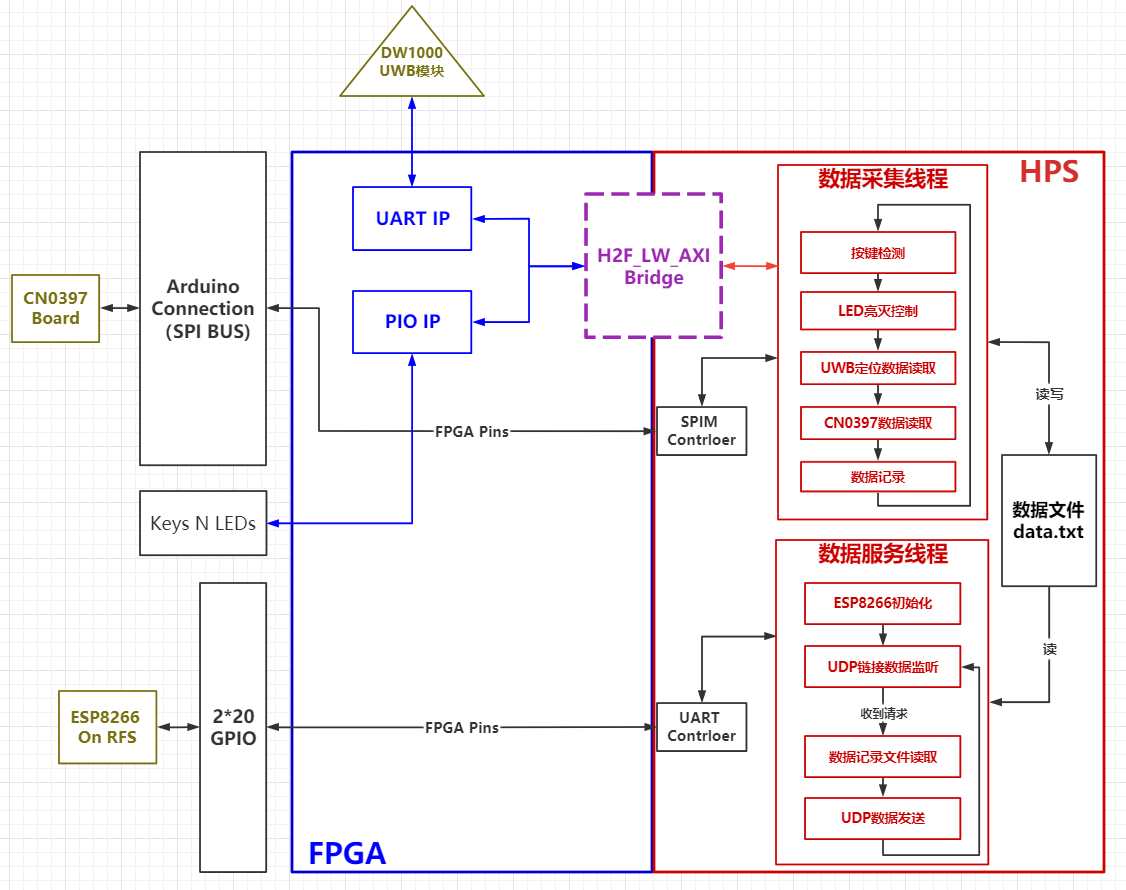 Other: SGP-Sustainable Agriculture
Other: SGP-Sustainable Agriculture
Smart and sustainable agriculture using FPGA
AP050 »
“Farm at ease” (Technology to farming):
To meet the growing population of the world, some serious reforms are required in the agricultural sector to ensure that our food system is ready to meet the upcoming challenges. This pushes us to shift from traditional/conservative agricultural practices to sustainable practices. Further, these sustainable practices are integrated with technological advancements, the major challenges of the agriculture/farming across the world can be resolved in an efficient and effective manner.
The following are some of the key challenges posed by the agricultural sector:
1. There is a considerable gap between the adoptions of technology in the agricultural sector when compared to the non-agricultural sectors especially in third world countries.
2. Mismanagement in crop planning without the proper analysis of soil.
3. Overutilization/underutilization of fertilizers.
4. Mismanagement in irrigation and thereby the water scarcity/wastage may occur.
5. Delay in identification of weeds/pests.
6. Unable to adopt the best practices of agriculture in the other regions.
Proposed solution:
To address above challenges, we are proposing for a design of a system (IOT based with Mobile/Web application development/Message alert system) which will aid the farmer in the following way:
1. Crop recommendation based on the soil condition, climate and water availability of that region.
2. Automatic irrigation system depending upon the crop requirement.
3. Recommendation of organic means of agriculture practice in place of fertilizers to the most possible extent.
4. Disease detection in crops using image processing.
5. Recommendation/alert system will be made in a simple manner and if possible, voice instructions will be given in regional languages.
Design idea:
The above-proposed idea will be designed initially as a real-time prototype device where FPGA board will be integrated with sensors such as NPK sensor, humidity sensor, temperature sensor, water level monitoring sensor, etc., Further, a communication shall be established between the FPGA board and mobile phone using FPGA virtues, Azure cloud, etc., This prototype device will be tested in a real-time agricultural field and based on the feedback/recommendations of the user (farmers) a robust system may be developed in future.
 Food Related
Food Related
农作物生长环境数据探测器
PR031 »
项目将开发一种农作物生长环境数据探测器,使用云连接套件并搭载ADI提供的土壤水分、pH 值和温度测量评估板和3通道光检测评估板,去田园的农作物之间采集光、水分、温度、湿度、土壤pH值等数据,同时定位采集地点,将生长环境数据连同位置等信息通过Wi-Fi模块上传到Azure LoT。其定位将通过UWB定位模块实现。在云连接套件中,Cyclone V的FPGA部分主要用于数据处理、无线通信等,而HPS部分主要用于控制从设备、执行算法,当然这二者之间可以互补,项目将逐步优化,把需要反复执行的数据处理等工作尽量交给FPGA部分,HPS部分则侧重协调调度和控制。本项目的预计使用场景是大规模大棚种植园。
 Health
Health
Musconnect
AS029 »
Neuromuscular diseases are one of the most common and yet hardest to diagnose anomalies. Most neuromuscular diseases are diagnosed at a very late stage where no cure can help the patient.
But what if this can change? The goal of Musconnect is to monitor almost 100 muscles in a patient simultaneously and in real-time. This mass of data is gathered over a period of time using microelectrodes that are connected to a patient. The electrodes data is transmitted to the FPGA, processed using the MCU and uploaded and stored in Azure. Using data analysis, the device will be able to predict any deterioration in muscle activities far before any doctor or patient can realize.
Moreover, Due to the ability of the device to monitor 100 major muscles across a patient’s body, the diagnostic will be able to pinpoint the exact location of the muscle abnormalities.A doctor can then decide the best treatment option rather than going through several expensive and inaccurate scans.
Since muscle activities are saved on the cloud, a patient/doctor will be able to monitor improvements in the treatments by comparing muscle contractions before and after diagnosis.
This is a major step in the medical field that will help millions of people around the world with a high degree of accuracy.
 Autonomous Vehicles
Autonomous Vehicles
Enhancing Vehicular Safety Using Cloud Based IOT
AP051 »
In this project we propose to build smart vehicle monitoring and assistance systems using cloud computing in vehicular Ad Hoc networks. Increasing number of on road vehicles has become a major source of unintended accidents. Developing intelligent transportation system using cloud based connected vehicular networks can provide better estimate of time of arrival and localization matrix of vehicles in a given range of interest. We propose to build a safety enhancement feature to cater to accidents that occur due to random stoppage of vehicles and random opening of doors. Sensors will be used to detect and estimate events related to stoppage and door opening and create an event token. This event token will be correlated with the time of arrival and localization matrix of vehicles in a given radius of the vehicle from where the token was generated. Based upon this correlation a warning system and door enable disable system will be implemented to avoid collision. Additionally, temperature and humidity sensors will be deployed inside the vehicle to automatically or partially open the windows for maintaining proper air flow and ventilation.
 Health
Health
基于FPGA的手语翻译系统
PR032 »
 Other: Agriculture
Other: Agriculture
Pursuit Futurology in Smart Agriculture using FPGA
AP052 »
The proposed system is a system which will closely monitor the parameters of a field on a regular basis round the clock for cultivation of crops or specific plant species which could maximize their production over the whole crop growth season and to eliminate the difficulties involved in the system by reducing human intervention to the best possible extent.
We mainly have Two Blocks for this Project:
a. HPS (Hard Processor System):
Our system will take multi-inputs from multiple sensors such as humidity, light intensity, temperature and IR sensor and give those parameters as input to the HPS automatic training module (as initial values). For certain time the process of taking multiple input will be repeated over time. These will be an input to the HPS. Post processing the data will give as input to the FPGA part.
b. FPGA (Field Programmable Gate Array (Terasic DE10-Nano FPGA)):
By taking the input data in HPS as input to the FPGA part of the board, the system will pre-process the data. Then, it compares both the data and make the result. The result will be sent to the display as a message
Our main aim of the Digital Farming is to improve agricultural yield and reduce potential environmental risks, while benefits are:
1. Water level sensing.
2. Atmospheric temperature sensing.
3. Atmospheric humidity sensing.
4. Detection of pest in the field and automatically start the pest repeller if pest is detected using IR sensor.
5. Suggest best measures to be taken by the farmer.
1. Water Level Sensing:
An advanced water level sensing sensor will be fixed in the field for monitoring the water level. Based on the information given to the system, our system will alert the farmer along with the water level percentage through message.
2. Atmospheric Temperature sensing:
A temperature sensing device will be fixed at the field for checking the temperature of the present atmosphere. Our employed FPGA will decide whether the atmospheric temperature is sufficient for field growth or not and send the information through message.
3. Atmospheric Humidity sensing:
An atmospheric humidity sensing sensor will be placed at the field for checking the humidity present in the atmosphere. The output of the sensor will be given as input to FPGA for checking humidity is high or normal for crops growing. Our system will send this Atmospheric humidity level to the farmer through message.
4. Detection of pests such as rodents:
Here using IR sensors detects the entry and exit of unwanted pests such as rodents.
5. Diagnosis and Suggest some measure to be taken by farmer:
After detecting the sensor inputs from the field, our system will send the actions to be taken and suggest some precautionary measures.
This project is divided into four phases: -
Identifying the appropriate sensor for measuring temperature and relative humidity. Temperature sensor to be used is RTD so that low-cost aim can be successful with best stability.
Design of controller using FPGA, sensor interface card, isolation circuit for input and output, output relay card.
Identify if there any pests enter into the premisses/field and take the necessary action if so.
Development of a user interface and the controlling software.
Since a FPGA(Terasic DE10-Nano FPGA) is used as the heart of the system, it makes the set-up low-cost and effective nevertheless. As the system also employs an LCD display for continuously alerting the user about the condition inside the greenhouse, the entire set-up becomes user friendly.
 Food Related
Food Related
Farm Management System
AP053 »
The project aims at developing an efficient farm management system that would prove to be resourceful in identifying pests on crops, report the nutrient and moisture content of soil, and accordingly irrigate the farm. For an efficient implementation, the system is integrated in a moving bot whose brain is the DE-10 Nano Cyclone V SoC FPGA board. For the time being, we are implementing our design on kharif crops, which can be further expanded to include rabi crops as well after suitable changes. For an efficient implementation, our project has further sub divisions as controlling the wheels of the bot, path tracking, analyzing the nutrients of the soil, image processing for detecting pests and irrigation system.
 Other: Disaster Prevention
Other: Disaster Prevention
Early Warning Alert System for Forest Fires
AS030 »
We are proposing a low-cost and low power wide-area sensor network that will quickly alert the authorities in case of a forest fire. The project will utilize a mesh network of low-power LoRa transmitter nodes connected to Temperature sensors. The network will be inactive until the temperature at any one node goes above a programmable specified limit, in which case the particular node will send an alert to the FPGA through the network. The FPGA will decide if the alert is real based on fire data modeling of the sensors and alert the authorities with the exact location of the fire.
 Other: Monitoring fire in rural areas
Other: Monitoring fire in rural areas
Fangorn
AS031 »
Fangorn project aims to develop a drone surveillance system to detect and monitor outbreaks of forest fires.A camera with an infrared sensor and some sensors (temperature, smoke, pressure) will be used to monitor and capture important data, which will be used in conjunction with computer vision techniques and the power of FPGA multiprocessing to classify whether or not there is a focus of fire in the area.
 Smart City
Smart City
Intelligent Pavement Damage Detection System for Urban Roads
PR033 »
Pavement damage on urban roads not only affects the appearance of the road surface and the comfort of driving, but also easily expands to cause structural damage to the road surface and shorten the service life of the road surface. If it is not repaired in time, it will cause local accelerated damage to the road surface, cause serious traffic accidents, and cause a large number of personal injuries and economic losses. In order to reduce such injuries and realize the sustainable use of urban roads, reasonable and timely road maintenance and management are particularly important, and road damage detection is the primary task of road maintenance and management. Therefore, this project designs an intelligent road damage detection system for urban roads based on 3D lidar and cameras, collects and analyzes road data in real time, and gives the damage results objectively and accurately.
The intelligent road damage detection solution we conceive uses multi-sensor fusion and uses FPGA edge hardware to accelerate processing and upload to the cloud server instead of manual detection. It can display the GPS location of road damage in real time, as well as accurate detection results. In addition, the road surface can be spliced to form a vectorized map, and the road surface condition index PCI can be calculated according to the size and shape of the defect, and maintenance personnel can be notified to make timely repairs.
 Smart City
Smart City
基于FPGA的3D人脸特征传输系统
PR034 »
随着社会的发展,人工智能在人们身边出现的越发频繁,智慧景区以及智慧城市也是当前的人们发展趋势,本设计顺应需求,针对部分场景,如景区中的游客流量、游客、性别等基础信息的统计,或无人超市中人物信息的识别以及保存,并将这些数据备份、发送到云端,并在app中对部分数据进行实时更新,在做数据统计与分析时,利用云端中存储的数据,可以很全面且客观的分析出现状,这些工作靠人力实践是非常耗时耗力的。在必要时,还可调用出对象的信息和图像,对图像进行伪3D显示,大大提高了人们对图像的感知力。基于此类功能以及特性,本设计可广泛推广于安保、有人员统计需求类的场景。
本设计以 DE10-Nano 开发板为平台,结合当前最新推出的 DE10 云套件 RFS 子卡搭建了一款物联网系统,在此基础之上加入摄像头、液晶显示屏以及四片半透明介质,组合构成对象人物信息提取系统和佩伯尔幻像伪全息人物显示系统,并通过在arm核中移植linux系统以及在此之上配置的opencv和openvino环境对获取的图像信息进行处理分析,所得到的数据传回fpga,通过云系统发送到app,实现实时对部分数据的监控,每隔一段时间会发送数据到数据库储存供以随时调用。并可通过调用信息,读取对象人物的信息,选择对象的照片进行全息显示。
 Industrial
Industrial
基于FPGA的多路JPEG-LS无损解压缩
PR035 »
随着相机技术的发展,像素分辨率与帧率都得到了大幅度提高,由此需要处理的图像数据量也随之越来越大。在一些如地理信息、医学影像、卫星侦察领域,因数据传输通道变化不大,所以需要对传输的图像数据进行压缩后传输,并在终端解压缩进行图像还原。而在图像压缩中,JPEG-LS具有显著的优势,它比JPEG2000的算法复杂度更低,比JPEG的压缩性能更强。所以JPEG-LS算法具有硬件易实现,复杂度低,同时具有较好的压缩性能。
基于JPEG-LS的压缩目前多采用硬件实现方案,但其解压缩却多采用软件解码方式,而软解存在CPU资源占用过多、功耗较大以及处理实时性等问题,尤其在多路软解下问题更突出。据此提出本项目“基于FPGA的多路JPEG-LS无损解压缩”以满足多路视频解码的实时性。
项目拟采用多路并行处理结构,对接读取的云端多路图像数据。系统由多路相机、服务器、FPGA DE10-Nano套件以及其他配套电路组成,拟实现对4路1080p@50Hz的视频压缩码流进行实时解码。其中压缩码流与解压码流均通过网络与服务器互联。
该方案在JPEG-LS解压缩的速度上有较大提高,尤其在多路图像数据(高帧率、高像素)的处理时,效果更为显著。通过该项目的实施可以较好体现FPGA的重构性、实时性、低能耗等性能。